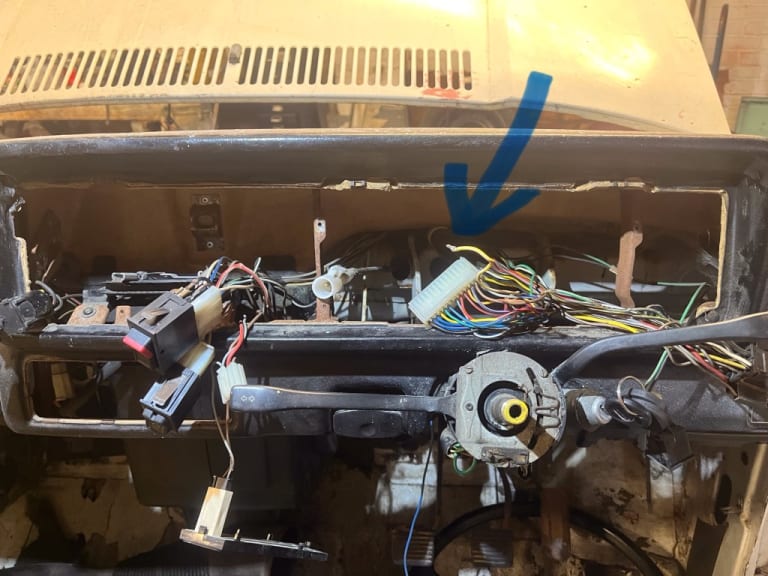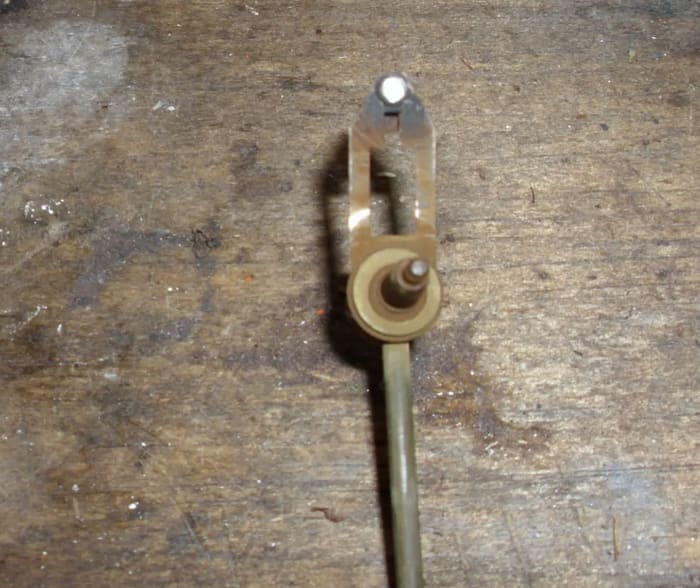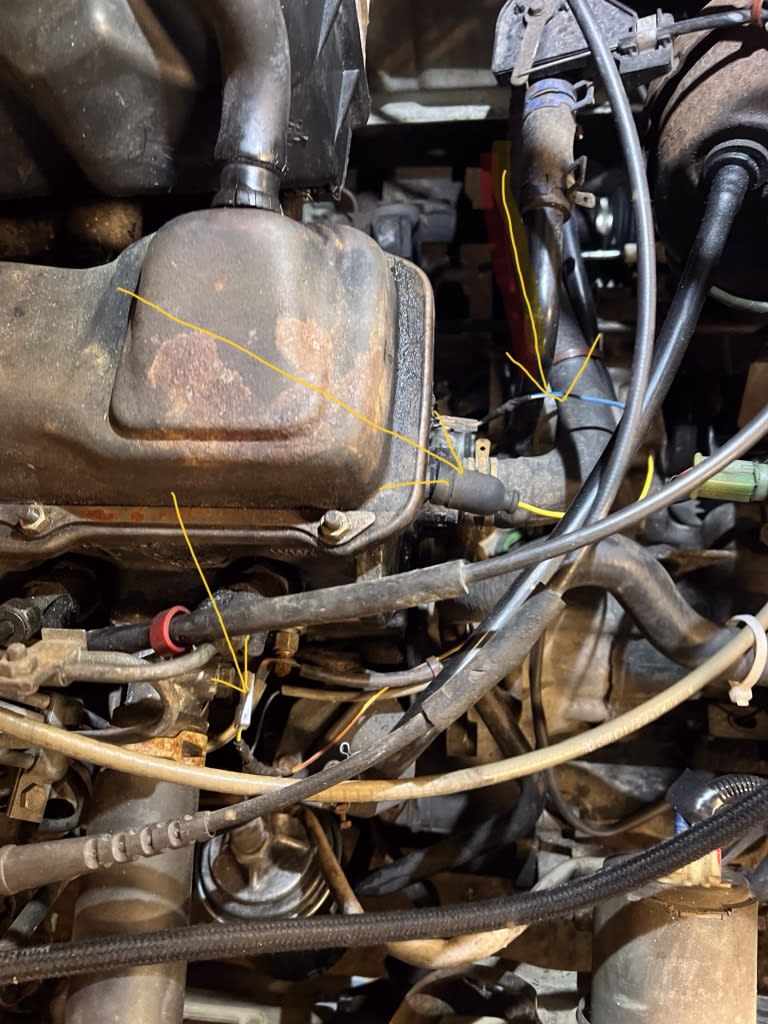Fuel gauge and temp gauge not working, ignition lights intermittent
Posted
#1676784
(In Topic #243931)
Old Timer


heres an image of the back of the binnacle, can anyone suggest further tests or can anyone see anything obviously wrong ?
ive arrowed a bit where it looks as tho the ring contact bit should be under the screw next to it, would I be correct? Cheers.


Posted
Local Hero

The Second is that your 10V stabilizer which powers both the Fuel, and Water temp Gauges is the second, hence the link to improving your cluster grounds and power, then testing your 10V stabilizer.
https://www.volkswagenownersclub.com/threads/improving-your-cluster-connections-and-ground.24949/?post_id=753377#post-753377

Yes a screw should possibly go to connect the Mylar to your gauge, but that isn't the cause of your gauge malfunction.
If you need to back feed your gauges then go to the link in my signature, (archive section here, then scroll to the electrical section.)
You can buy a new voltage stabilizer for 30-40-60 quid on line, or go to a good electrical parts store and get a ka7810-aet for less than 2 quid.
https://www.ebay.co.uk/itm/166942884269
or
171919803 Voltage regulator | HERITAGE STOCKS - Original Parts
Same 171919803, just the difference in mark up.
Be warned some of the Data sheets for the LM7810 ARE INCORRECT. The Bentley is Correct. If you replace the stabilizer and don't get the proper voltages on the pins, flip t over and try gain.
Found this out a long time ago.
 Last edit: by Briano1234
Last edit: by Briano1234
What do Divorces, Great Coffee, and Car Electrics all have in common?
They all start with GOOD Grounds.
Where are my DIY Links?
They all start with GOOD Grounds.
Where are my DIY Links?
Posted
Old Timer


Thanks man 👍🏽
Posted
Old Timer


I've done the modifications as per good ole Briano's advice. I cleaned up around the terminals on both gauges and I also tested the voltage stabiliser which was producing about 4.5V, so I installed a new one and it tested at 9.8V…. Still no gauges….
I've arrowed a loose wire from the multi plug in the image, to be fair it looked on initial removal of the binnacle as though it had never been connected , but anyway, can anyone identify what this wire does??

Posted
Old Timer


Truck is a 1988 1.6 Derv. Truck.
Posted
Local Hero

What do Divorces, Great Coffee, and Car Electrics all have in common?
They all start with GOOD Grounds.
Where are my DIY Links?
They all start with GOOD Grounds.
Where are my DIY Links?
Posted
Old Timer


I've tested the gauges via putting 12V to each gauge and they both work.
So it must be a binnacle issue ?
Posted
Old Timer


Posted
Newbie

Posted
Local Hero

gauge. If you fail to get a ground at the Gauge or Voltage, then you can back feed it from the connector.
which I have had to do on one of my clusters once as the Mylar was broken.
See:
https://www.volkswagenownersclub.com/threads/90ish-cabriolet-mylar-repair-for-10v-stabilizer.60258/?post_id=531266#post-531266
What do Divorces, Great Coffee, and Car Electrics all have in common?
They all start with GOOD Grounds.
Where are my DIY Links?
They all start with GOOD Grounds.
Where are my DIY Links?
Posted
Old Timer


Posted
Old Timer


!! I'm bound to mess it up !
As for de-solder braid …… how does that work ?? 😝
Posted
Old Timer


So the way I understand it, for the fuel gauge at least, there should be a 10V + supply, an earth, and a supply from the sender, all at the gauge…..
Headscratch
Is that correct ??
Posted
Old Timer



Posted
Local Hero

jazzydog said
I'll test for continuity and go from there……
So the way I understand it, for the fuel gauge at least, there should be a 10V + supply, an earth, and a supply from the sender, all at the gauge…..
Headscratch
Is that correct ??
Not quite, the Ground for the Gauge is coming from the Tank, and based on how much fuel is in there your ground or sense wire could be from 30-to-300 Ohms resistance.
Here are the internals of the fuel gauge.

Here is the Sender.

Here is the Float arm.

Here are the Circuits.


Ok, first things first.
VW uses 10V stabilized voltages fo the bias of the gauges, this is because the battery under charge can go from 13v to 12.5 to 13 under load from additional circuits being turned on or off.
This stabilized 10V prevent fluctuations of the needle, making it stable as there is a known good reference point of 10V rain or shine load or no load on the electrics, and gives a point of reference to the unit that at empty the needle will move to the left and indicate full.
One side of the needle is 10V Positive.
From the sending unit in the tank, there is a resistor that one side of the PCB is Ground (brown wire on to of the Sender). This ground on one side can vary resistance via the Potentiometer (variable resistor) by the swing of the arm. This increases or decreases the ammount of current that can flow to the Gauge on the violet wire.
Inside of the Gauge is a Nicachrome wire wrapped around a bi-metalic strip.
When the gauge s working this wire heats up and makes a Bi-metallic strip bend and pulls against a spring, since the needle on the gauge is attached to it, the needle moves.
The use of the heater and bi-metalic spring to move the needle is that when you are driving and make a hard right turn, the float moves about and yet since it takes a while for the heated wire in the gauge to cool off to change position, it says where its at while you are doing acrobatics with your car and fuel sloshing about the tank.
When the resistance in the Tank is at MAX about 400 Ohms, the needle is at minimum value, and your float arm is at the bottom of your tank.
When you fill up your tank it decreases resistance to @ 31 Ohms and your gauge is showing full.
Very simple circuit. not like your diagram at all.
How a Fuel Gauge Works - YouTube
Causes of a malfunctioning gauge.
Broken wires from the sender to the Gauge (violet).
Cold solder joints on the Sender or inside your gauge.
Dirt on your Potentiometer scale and or bad wiper finger.
Bad 10V stabilizer
Bad or broken mylar runs in the cluster
see:
https://www.volkswagenownersclub.com/threads/repairing-your-fuel-sending-unit.78890/#post-600458
What do Divorces, Great Coffee, and Car Electrics all have in common?
They all start with GOOD Grounds.
Where are my DIY Links?
They all start with GOOD Grounds.
Where are my DIY Links?
Posted
Old Timer


I see !
💡
So basically the gauge has a 10V supply for stabilisation, and the electricity runs to ground via a variable resistor (which is the sender unit, swiper bit)……
Got it!
Thanks man !
Now I understand , and shall get on with fault finding 🌈
Posted
Local Hero

jazzydog said
Ahhh!!!!!
I see !
💡
So basically the gauge has a 10V supply for stabilisation, and the electricity runs to ground via a variable resistor (which is the sender unit, swiper bit)……
Got it!
Thanks man !
Now I understand , and shall get on with fault finding 🌈
A little backwards thinking from real life.
Electricity for beginners. lesson 101.
Think of a river when you think of electricity.
The flow of the water in the river is Current. it is what is moving.
Touching the river water with your hand or toe tells you how wet it is. This is where you measure for Voltage in a Circuit.
Putting a piece of wood tied with a string and measuring how fast it can travel in a given time is measuring the speed of the flow or the Current, which is how you measure for amperage in a Circuit.
If a Tree falls in to the river and the water is dammed a bit then rises and overcomes it is the Resistance in the current, Same as in electricity but measured in Ohms.
While in the oldie days folks were taught that voltage travels in a circuit from +12 to ground prior to the early 1960's. We are now taught that current in a circuit actually flows from the ground to the Positive force.
Ohm's law is E electromotive force, measured in volts is egual to the Current measured in Amps times the Resistance in the circuit measured in OHMS.
E=IR. You can't get around Ohms Law.
A open is negative current flow in a circuit as in a Broken wire.
A short is a direct tie between ground and the Positive voltage point, that usually gets a fuse overly excited and
I Blows it's Cookies which then causes an open in the circuit to prevent Dash Fires and such.
There are 2 types of circuits in the world Series and Parallel. They are measured differently. how and why is in my primer.
Thus ended the lesson.
So in your gas gauge, if you use a 9V DC battery with the positive side of the battery to the violet sending wire and Ground on the take frame, your gauge should register full or 3/4 of full, this validates your current path from the Sending unit connector to the Gauge being good.
If you take the violet to ground then your gauge goes to empty.
If the gauge fails to move then apply 9VdC directly to the gauge as well as ground and if your meter don't move the issue is in the meter probably a cold solder joint, more common in the water gauge.
What do Divorces, Great Coffee, and Car Electrics all have in common?
They all start with GOOD Grounds.
Where are my DIY Links?
They all start with GOOD Grounds.
Where are my DIY Links?
Posted
Old Timer


So, I've done all the checks and mods to the cluster and now my fuel gauge works perfectly.
The weird thing is, the temp gauge isn't happy.
I've run the engine up to hot, and seen the cooling fan kicking in and out, the temp gauge is moving, but only slightly, showing a cold engine when it's clearly hot, and also, the little red light on the temp gauge is constantly flashing from ignition on. Cold.
I thought the red flashing light was coolant level, but there is no sender on the header tank ??
Am I right to be cleaning up the number 43 relay above the fuse box next ?
And could anybody advise which senders do what at the cylinder head and coolant flange please ?

Posted
Old Timer


Pretty certain there is only one temp sender that is on the coolant flange, the one on the side of the head is one of the oil pressure senders.
Posted
Old Timer


I am mistaken, there is a coolant level sender in the header tank. I whipped it out and cleaned off the crud on the probes and refitted it, voila !! The flashing light on the temp gauge went away.
My only issue now is the temp gauge not reading correctly.
As I mentioned, I've run the engine up to temp, probably for the first time in several years. I found a coolant leak from one of the hoses and on inspection three of the hoses look / feel suspect. I've now replaced the thermostat and await delivery of the replacement hoses….
I think I may as well replace the temp sender as well and go from there….
0 guests and 0 members have just viewed this: None.








